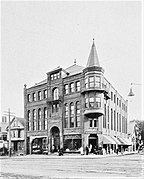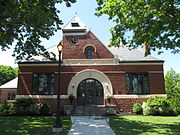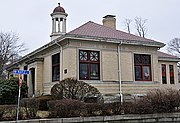George F. Loring
George Fullington Loring | |
|---|---|
 George F. Loring, circa 1896 | |
| Born | March 26, 1851 |
| Died | February 1, 1918 (aged 66) |
| Nationality | American |
| Occupation | Architect |
George Fullington Loring (1851–1918) was an architect from Boston, Massachusetts.
Life and career
[edit]George Fullington Loring was born March 26, 1851, in Boston to George and Harriet Abba (Stoodley) Loring.[1] He was educated in the public schools, with supplementary classes in the free drawing school of the Lowell Institute under the direction of George Hollingsworth.[2] From 1868 to 1882 he was employed in the city surveyor's office of Boston. From 1882 to 1884 he was employed in the office of architect George A. Clough.[3] In the latter year Loring established his own architecture practice.[4] In 1889 he formed a partnership with Sanford Phipps, formerly employed in the Boston office of Worcester architect Stephen C. Earle.[3] The firm of Loring & Phipps became notable, in particular, for their designs for large school buildings throughout the northeast United States.[4]
This partnership continued until Loring's death in 1918. Phipps continued to practice until his own death in 1921.
Personal life
[edit]Loring was a descendant of Thomas Loring of Hingham.[1]
Loring married in 1873 to Sarah Frances Johnson of Somerville, a descendant of Edward Johnson of Woburn. The couple lived in Somerville, from 1895 occupying a large family home built from Loring's design. They had four children.[1] Both of their sons followed their father into the business. His eldest son, Ernest Johnson Loring (1874-1926), attended the architectural school of the Massachusetts Institute of Technology, graduating in 1895. He worked for his father's firm from them until 1901, and for Earle & Fisher until 1902, before changing careers.[5] Their third child, Ralph Stoodley Loring (1879-1948), also attended MIT and would go on to be an architect of some note in Idaho and California.[6]
Loring was prominent in Masonic circles, and was architect of the Masonic Temple in Boston and the Masonic Apartments in Somerville. He was also a founding member of the Somerville Historical Society, now the Somerville Museum, in 1898. Mrs. Loring was also a member of the society.
Loring died February 1, 1918, in Somerville at the age of 66.[6] He was a distant relative of fellow Boston architect Charles Greely Loring, partner of Joseph D. Leland in the firm of Loring & Leland.[1]
Legacy
[edit]A number of buildings designed by Loring, alone and in association with Sanford Phipps, have been listed on the United States National Register of Historic Places.[7] Others contribute to listed historic districts.
Architectural works
[edit]- Somerville Public Library (former), Somerville, Massachusetts (1884, demolished)[3]
- Odd Fellows Building, Somerville, Massachusetts (1885, demolished)[3]
- Stickney Building and Masonic Apartments, Somerville, Massachusetts (1888, demolished)[8]
- Flint Public Library, Middleton, Massachusetts (1890–91, NRHP 2002)[9]
- Miner Hall and Paige Hall, Tufts University, Medford, Massachusetts (1891–92)[10]
- Athol High School (former), Athol, Massachusetts (1892, demolished)[11]
- Edward Devotion School, Brookline, Massachusetts (1892–93 and 1898–99, demolished 1953 and 1974)[12]
- Everett High School (former), Everett, Massachusetts (1892–93 and 1905)[13]
- Havemeyer School (former), Greenwich, Connecticut (1892)[14]
- Montclair High School (former), Montclair, New Jersey (1892, demolished)[15]
- Ware High School (former), Ware, Massachusetts (1893)[16]
- George W. Durell School (former), Somerville, Massachusetts (1894)[17]
- Glenfield School, Montclair, New Jersey (1895–96)[18]
- Gilbert School (former),[a] Winsted, Connecticut (1895)[19]
- Hopkinton Public Library, Hopkinton, Massachusetts (1895)[20]
- House for George F. Loring, Somerville, Massachusetts (1895, NRHP 1989)[21]
- Masonic Temple, Boston, Massachusetts (1897–99)[22]
- Weymouth High School, Weymouth, Massachusetts (1898, burned and demolished 1971)[23]
- Stoneham High School (former),[b] Stoneham, Massachusetts (1900–01)[24]
- Athens School (former), Weymouth, Massachusetts (1901–02)[25]
- Hyde Park High School (former),[c] Hyde Park, Boston, Massachusetts (1902)[26]
- Westerly High School (former), Westerly, Rhode Island (1902–03, demolished)[27]
- Stoneham Public Library, Stoneham, Massachusetts (1904, NRHP 1984)[28]
- Clubhouse, Brae Burn Country Club, West Newton, Massachusetts (1905)[29]
- Harvard School, Harvard, Massachusetts (1905, demolished)[30]
- Walpole High School, Walpole, Massachusetts (1907)[31]
- Everett Central Fire Station, Everett, Massachusetts (1908)[32]
- Masonic Building, Everett, Massachusetts (1910)[33]
- Chapel, Woodlawn Cemetery, Everett, Massachusetts (1911)[34]
- William H. McElwain School, Bridgewater, Massachusetts (1912, NRHP 2013)[35]
- Burlington Town Hall (former), Burlington, Massachusetts (1915, demolished)[36]
Gallery of architectural works
[edit]-
Odd Fellows Building, Somerville, Massachusetts, 1885.
-
Stickney Building and Masonic Apartments, Somerville, Massachusetts, 1888.
-
Flint Public Library, Middleton, Massachusetts, 1890-91.
-
Miner Hall, Tufts University, Medford, Massachusetts, 1891-92.
-
Havemeyer School, Greenwich, Connecticut, 1892.
-
George W. Durell School, Somerville, Massachusetts, 1894.
-
Gilbert School, Winsted, Connecticut, 1895.
-
Glenfield School, Montclair, New Jersey, 1895-96.
-
Hopkinton Public Library, Hopkinton, Massachusetts, 1895.
-
Masonic Temple, Boston, Massachusetts, 1897-99.
Notes
[edit]- ^ Now a building of the Northwestern Connecticut Community College.
- ^ More recently known as Central School.
- ^ More recently the William Barton Rogers School.
References
[edit]- ^ a b c d Charles Henry Pope and Katharine Peabody Loring, Loring Genealogy (Cambridge: Murray and Emery Company, 1917)
- ^ "Loring, George Fullington" in Who's Who in New England, ed. Albert Nelson Marquis (Chicago: A. N. Marquis & Company, 1916): 684.
- ^ a b c d "Loring, George F." in Boston of To-day: A Glance at its History and Characteristics, ed. Edwin M. Bacon (Boston: Post Publishing Company, 1892): 296.
- ^ a b "Loring, George Fullington" in The National Cyclopaedia of American Biography, vol. 11 (New York: James T. White & Company, 1909): 328.
- ^ Class Book: 25th Anniversary (Boston: Massachusetts Institute of Technology Class of 1895): 84-85.
- ^ a b "Publisher's Department, Western Architect 27, no. 3 (March 1918): viii.
- ^ "National Register Information System". National Register of Historic Places. National Park Service. July 9, 2010.
- ^ Historic Address by Brother Aaron Sargent at the Dedication of the Masonic Apartments in Somerville (Somerville: Somerville Journal Print, printers, 1888)
- ^ "MDL.1." mhc-macris.net. Massachusetts Historical Commission, n. d. Accessed June 23, 2021.
- ^ Keith N. Morgan, Buildings of Massachusetts: Metropolitan Boston (Charlottesville: University of Virginia Press, 2009)
- ^ "ATH.82." mhc-macris.net. Massachusetts Historical Commission, n. d. Accessed June 23, 2021.
- ^ "BKL.2529." mhc-macris.net. Massachusetts Historical Commission, n. d. Accessed June 23, 2021.
- ^ "EVR.159." mhc-macris.net. Massachusetts Historical Commission, n. d. Accessed June 23, 2021.
- ^ Greenwich Avenue Historic District NRHP Registration Form (1988)
- ^ Henry Whittemore, History of Montclair Township, State of New Jersey (New York: Suburban Publishing Company, 1894)
- ^ "WAR.39." mhc-macris.net. Massachusetts Historical Commission, n. d. Accessed June 23, 2021.
- ^ "SMV.227." mhc-macris.net. Massachusetts Historical Commission, n. d. Accessed June 23, 2021.
- ^ "School Building Notes," School Journal 51, no. 9 (September 14, 1895): 228.
- ^ "Loring, George Fullington" in Somerville, Past and Present: An Illustrated Historical Souvenir, ed. Edward A. Samuels and Henry H. Kimball (Boston: Samuels and Kimball, 1897): 582.
- ^ "HPK.189." mhc-macris.net. Massachusetts Historical Commission, n. d. Accessed June 23, 2021.
- ^ "SMV.36." mhc-macris.net. Massachusetts Historical Commission, n. d. Accessed June 23, 2021.
- ^ "BOS.2309." mhc-macris.net. Massachusetts Historical Commission, n. d. Accessed June 23, 2021.
- ^ History of Weymouth, Massachusetts, vol. 2 (Weymouth: Weymouth Historical Society, 1923)
- ^ "Building Intelligence," American Architect and Building News 68, no. 1278 (June 23, 1900): xi
- ^ "WEY.302." mhc-macris.net. Massachusetts Historical Commission, n. d. Accessed June 23, 2021.
- ^ "BOS.18574." mhc-macris.net. Massachusetts Historical Commission, n. d. Accessed June 23, 2021.
- ^ "New Schools," American School Board Journal 24, no. 1 (January 1902): np.
- ^ "STN.28." mhc-macris.net. Massachusetts Historical Commission, n. d. Accessed June 23, 2021.
- ^ "The Brae Burn Country Club House," Carpentry and Building 27, no. 5 (May 1905): 126.
- ^ "HRV.222." mhc-macris.net. Massachusetts Historical Commission, n. d. Accessed June 23, 2021.
- ^ "WLP.143." mhc-macris.net. Massachusetts Historical Commission, n. d. Accessed June 23, 2021.
- ^ "EVR.1." mhc-macris.net. Massachusetts Historical Commission, n. d. Accessed June 23, 2021.
- ^ "EVR.63." mhc-macris.net. Massachusetts Historical Commission, n. d. Accessed June 23, 2021.
- ^ "EVR.800." mhc-macris.net. Massachusetts Historical Commission, n. d. Accessed June 23, 2021.
- ^ "BRD.119." mhc-macris.net. Massachusetts Historical Commission, n. d. Accessed June 23, 2021.
- ^ "Boston, Mass.," American Contractor 36, no. 31 (July 31, 1915): 55.














